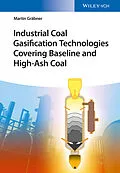The ongoing discussion about reaching the "peak-oil point" (maximal delivery rate with conventional methods) emphasizes a fundamental change of the frame conditions of oil-based basic products. The alternative with the largest potential is the use of coal. Coal gasification is the production of coal gas (a mixture of mainly hydrogen and carbon monoxide) from coal adding agents like steam/water and oxygen, which can be used in a number of industrial processes (e.g. hydroformulation and Fischer-Tropsch process). Many different kinds of coal do naturally occur, and due to shrinking natural resources, there has been a substantial gain of interest in poor, ash-rich coal. Beside the quality of coal, there is a number of other parameters influencing the efficiency of coal gasification, such as temperature, pressure, and reactor type.
Although several books dealing with the subject of gasification have recently been published, few are strictly focussed on coal as feedstock. This monograph provides the reader with the necessary chemical background on coal gasification. Several types of coal (baseline coal and ash-rich coal) are compared systematically, pointing out the technological efforts achieved so far to overcome this challenge. Using a new, innovative order scheme to evaluate the gasification process at a glance (the ternary diagram), the complex network of chemistry, engineering, and economic needs can be overviewed in a highly efficient way.
This book is a must-have for Chemical and Process Engineers, Engineering Students, as well as Scientists in the Chemical Industry.
Autorentext
Dr.-Ing. Martin Grabner is senior research engineer for coal gasification at the Research and Technology Center of Air Liquide in Frankfurt/Main, Germany. Receiving scholarships from the Konrad-Adenauer-Stiftung and from the German National Academic Foundation, he has studied energy process engineering at the Technische Universitat Bergakademie Freiberg, Germany, and the University of Cincinnati, Ohio.
For his excellent course of studies, he received the Georgius Agricola Medal and the Helmut Erich Rammler Award. While obtaining his doctoral degree from the Technische Universitat Bergakademie Freiberg, Germany, he spent several years working as team leader of the gasifier development group at the Institute of Energy Process Engineering and Chemical Engineering in Freiberg.
Inhalt
Preface XV
1 Introduction 1
References 2
2 Coal Gasification in a Global Context 3
2.1 Applications of Coal Gasification 3
2.2 The Three Generations of Coal Gasifiers 4
2.2.1 First Generation of Coal Gasifiers 5
2.2.2 Second Generation of Coal Gasifiers 5
2.2.3 Third Generation of Coal Gasifiers 6
2.3 Typical Feedstock and Products 9
2.3.1 Feedstock 9
2.3.2 Products 9
2.4 Main Markets for Coal Gasification 16
2.5 Challenges and Opportunities for Coal Gasification 16
2.6 Environmental Aspects 18
2.6.1 Air Emissions 18
2.6.2 Water Effluents 20
2.6.3 Solid Waste 20
References 21
3 Coal Characterization for Gasification 25
3.1 Coal as Gasification Feedstock 25
3.2 Petrographic Coal Analysis 26
3.2.1 Introduction to Macerals 26
3.2.2 Technological Background 26
3.2.3 Groups of Macerals 27
3.2.4 Blend Identification 30
3.2.5 Temperature Estimation Using Optical Reflectance 33
3.2.6 Detection of Other Material 34
3.3 Coal Classification 35
3.3.1 Introduction 35
3.3.2 Reporting of Coal Analyses 36
3.3.3 Classification According to the American Society for Testing and Materials Standard 38
3.3.4 Classification According to the International Organization for Standardization 40
3.3.5 Other Nomenclatures Relevant to Gasification 40
3.4 Coal Sampling 43
3.5 Proximate Analysis 44
3.5.1 Moisture Content 44
3.5.2 Ash Content 46
3.5.3 Volatile Matter Content 47
3.5.4 Fixed Carbon 48
3.5.5 Alternative Method 48
3.6 Fischer Assay 48
3.7 Ultimate Analysis 49
3.7.1 Technological Background 49
3.7.2 Analysis Procedure 49
3.7.3 Carbon 50
3.7.4 Hydrogen 51
3.7.5 Nitrogen 51
3.7.6 Sulfur 52
3.7.7 Oxygen 53
3.7.8 Chlorine 53
3.8 Heating Values 54
3.8.1 Technological Background 54
3.8.2 Analysis Procedure 54
3.8.3 Estimation by Empirical Correlations 55
3.8.4 Enthalpy of Formation 55
3.9 Caking Properties 57
3.9.1 GrayKing Assay 57
3.9.2 Free-Swelling Index 58
3.9.3 Roga Index 58
3.9.4 Dilatation Test 59
3.10 Reactivity 59
3.10.1 Technological Background 59
3.10.2 Determination of Reactivity 60
3.10.3 Spontaneous Ignition 67
3.11 Mineral Matter and Ash Analysis 68
3.11.1 Technological Background 68
3.11.2 Minerals in Coal 69
3.11.3 Transformation of Mineral Matter to Ash 71
3.11.4 Ash Component Analysis 72
3.11.5 Ash Fusion Analysis 73
3.11.6 Slag Viscosity Analysis 79
3.11.7 Devolatilization of Mineral Compounds 84
3.11.8 Utilization Properties of Ash and Slag 86
3.12 Relevant Physical Properties 86
3.12.1 Coal Density 87
3.12.2 Thermal Properties 90
3.12.3 Granulometric Properties 91
3.12.4 Fluid-Dynamic Properties 95
References 100
4 Fundamentals 107
4.1 Terms and Definitions 107
4.2 Gasification Reactions 108
4.3 Pyrolysis Reactions 109
4.4 Gasification Parameters 110
4.5 Classifying Gasification Methods 112
4.5.1 Bed Type (Particle Size) 112
4.5.2 Temperature Range 114
4.5.3 Pressure Level 116
4.5.4 Feeding Method 116
4.5.5 Wall Type 120
4.5.6 Syngas Cooling 121
4.5.7 Oxidant 122
4.5.8 Solid Residue Removal 123
4.5.9 Addition of Catalysts 124
References 126
5 Coal Gasification Modeling 129
5.1 Introduction 129
